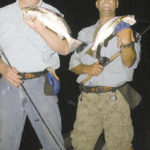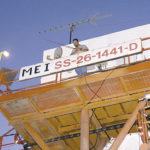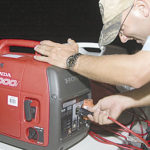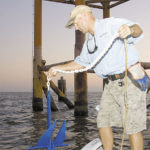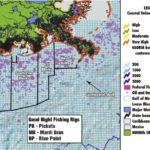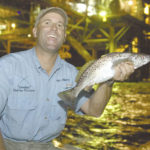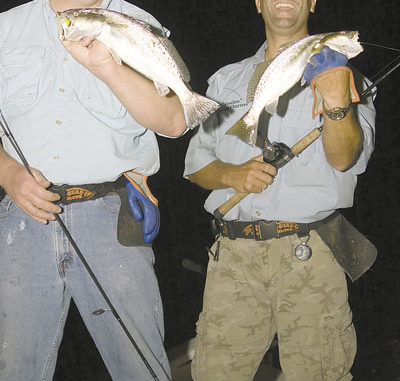
You’ll be tempted to start doing your favorite disco dance when you see how fast the after-dark speck action is this month south of DuLarge.
Now I know what driving against contra-flow must feel like. The boats that were getting out of Bayou DuLarge down at Jug’s were making it difficult for us to get in. However, had it not been for the brutal heat that has gripped Louisiana this summer, we might have been among the ones leaving rather than launching.“That’s not true,” said Capt. Marty LaCoste with Absolute Fishing Charters. “I would be launching late even if it we weren’t having this searing heat. I fish at night from April through August no matter what the weather is doing. Fishing at night is all about the bite under the light; the cooler temperature is just a bonus.”
LaCoste has been catching trout under the lights below the mouth of Bayou DuLarge for the last 13 years, and this night he wanted me to experience the thrill of slinging in trout that we could hardly see two at a time.
As we idled past rows of camps on either side of us, LaCoste pointed out to his friend Capt. Joel Wakeland with Big Red Charters that he hoped it would be “slicked out tonight.” I had news for him; the likelihood of the wind not blowing while I was in his boat was slim to none.
“I’m a walking wind machine,” I exclaimed. “You want to go fly a kite, you call me to make sure the wind is blowing. You want to get in some sailboat time, bring me along. If you want it to be slicked out — you should have left me at the landing.”
By the time we hit the mouth of Bayou DuLarge, it was evident that my inner turbines were starting to spin. The chop heading out into the Gulf of Mexico wasn’t too bad, but it brought to mind something LaCoste had explained back at the landing.
“When the water is clean and slick calm,” he had started, “we like to throw topwaters. It’s amazing to see all the trout that will come up to investigate and try to bite it. We’ll see them swimming below the topwater 10 to 15 at a time. They’ll follow it all the way to the boat if one of them doesn’t smack it first.”
So the thrill of the topwater bite wasn’t going to happen, but as he idled up toward Ship Shoal 26 at what is called The Pickets, a group of rigs just to the west of Coon Point, LaCoste grabbed my rod that had one salt & pepper MirrOlure Soft Sardine and one glow/chartreuse V&M Marsh Minnow looped around the reel handle.
“This is all you’re going to need tonight,” he assured. “We ought to be able to bust them up big time on these tandem rigs. Now all we got to do is sit back and wait on the boogie to begin.”
We didn’t have to wait too long. Before the sun sank below the western horizon, we were already getting bumps on our tandem rigs. The initial flurry turned out to be a school of white trout, but we picked up a few nice specks before it got dark. LaCoste said these fish were lagniappe.
After unhooking one of the larger trout of the trip, LaCoste noticed a rig worker walking the platform overhead. Knowing that this fellow would have the goods on what was going on, he engaged him in some small talk about the fishing.
“Da trout been turning on ‘bout 11 o’clock,” said Travis Freeman from down on Bayou Blue. “I catch a few good specks every night, me. Dey been some big trout hitting every now and den, too.”
Freeman made a cast from the top of the platform.
“I like to fish up here to see if dey hitting before I walk down,” he said. “I get a couple bumps, I come down and fish a while. Been catching some by dat corner you fishing right now. And from up here I can see dem swimming around under dose lights.”
Acting as our eye-in-the-sky, Freeman kept up the aerial advice as we continued to work around the rig. Not wanting to lose his best spot to a late arriver, LaCoste got in position between two big sections of the rig, and dropped his anchor. All we did for the next hour was haul water.
“This is when most people would leave,” said Wakeland as the edge between light and darkness was just starting to get distinctive. “The big bite doesn’t always happen right at sunset. It all depends on what the bait is doing. Sometimes we start catching them right away, and sometimes they don’t turn on until an hour or two after dark.”
LaCoste started lamenting about how the water wasn’t moving much. He had checked the tide, and he thought it should be rising as we sat there waiting on the action to begin. However, by the way our baits were coming right back in without getting pushed to the side, we could tell it hadn’t started yet.
“You see this iPhone app yet?” I asked LaCoste. “It’s called Tide Graph 2.0, and it shows you real-time data from lots of locations along Louisiana’s coast.”
I hit the app button, and my phone asked me if it could use my current location. I clicked OK. Raccoon Point showed up as my closest choice, so I clicked it. The app showed me that the tide was rising at Coon Point. Considering we were about nine miles to the west of Coon Point, LaCoste thought it might be another 20 minutes or so before we saw any movement.
Within about 10 minutes, we noticed our lines starting to bow to the left as our baits slowly began to get swept along in the tide. We also noticed some shrimp starting to pop the surface. And the most telling sign that the bite was about to begin, at least in my mind, was that the rig worker had moved down to the base of the rig with his fishing gear in hand.
We fished what LaCoste called his best spot for about 30 minutes, and it quickly became evident that the fish weren’t on that particular corner. We tried the corner behind the boat with the same results. Freeman had walked to a corner on the other side of the rig just moments before hollering out to us that the fish were over there.
Before we even rounded the corner, we could see trout slashing the surface. Freeman didn’t have much time for us as he was in the middle of yanking his third trout onto the metal walkway. A few well-placed casts by all three of us in the boat turned on the fish-catching switch.
Even though the fish were biting, I couldn’t help but think we could be doing better. I asked LaCoste if we should reposition the boat based on the current, but he would have none of it.
“At night,” he began, “none of that stuff matters. All that matters at night is the lights. You could fish upcurrent, downcurrent — it doesn’t matter. If you’re under a light, you’re going to catch fish. Some may be high. Some may be low. That doesn’t matter either as long as that light is shining in the water. It’s all about the light at night.”
As it sometimes does, the bite on this corner eventually shut off, so LaCoste started looking around for another hot corner. He found it off of an extension of the main rig, but he felt like the light wasn’t strong enough. A couple bumps later, he was cranking up his generator and hooking up his own lights.
“Sometimes you’ve got to take matters into your own hands,” he said as he pointed the lights toward a dark corner between a pilling and a small platform. “I bring the generator as a backup. On some nights when there are a lot of people out, if you can’t get on a light you basically can’t fish. These lights allow me to go anywhere I want to and catch fish.”
LaCoste pointed out that he has caught fish as quickly as five minutes after putting out the lights on a dark rig, but he added that it could also take up to an hour for the baitfish to respond, which is key to getting the trout to respond. However, the ability all this extra gear gives him to make his own hotspots makes bringing it along every trip worth it in the long run.
Although LaCoste had hoped to be limited out and back at the launch by midnight, it didn’t work out for us that way on this particular night. He had told me earlier that fishing at night gave him about a 98-percent guarantee of limiting out; we were in the much smaller 2 percent. We didn’t hit the limit, but the action was fast and furious when it turned on.
“It wasn’t on tonight,” LaCoste lamented as we idled by the camps again on our way back in. “When everything is right, you can see the shrimp and trout, and it’s two at a time when they turn on. We could blame it on a lot of things tonight, but why bother? We caught a good box of trout. We didn’t have to fight the bugs or the heat. What more could anybody want?”
How about another trip?
Contact Capt. Marty LaCoste at 985-856-4477. Contact Capt. Joel Wakeland at 504-952-8096. Follow the author’s blog at www.chrisginn.com.
